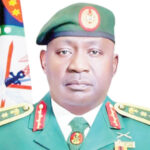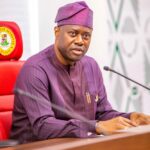On August 28, this year, this reporter, alongside 15 other participants of the United States International Visitor Leadership Program on Investigative Journalism and New Electronic Media, drawn from various African countries, was a witness to where 500 years of news history blends with up-to-the-second technology.
The 250,000-square-foot museum of news features seven levels of galleries, theaters, retail spaces and visitor services, which take visitors to five centuries of news history, the latest news technology and offers behind the scenes experience of how and why news is made.
We were first greeted by a larger than life 74-foot-tall marble First Amendment tablet, containing the 45 words that form the corner stone of U.S. democracy and freedom of the press.
A two-hour tour into the museum by a volunteer guide, Mr. James Fire was indeed momentous. Some of the important eye-catching galleries include Today’s Front Pages Gallery, where 80 enlarged front pages of different newspapers from America and across the world are displayed daily. More than 700 newspapers transmit their front pages electronically to the Newseum every day. Of the 80 we met that day, only one was from Africa – Sudan.
There was “A Tribute to Journalists Who Have Died Pursuing the News,” a gallery which houses the Journalists Memorial, a soaring, two-storey glass structure bearing the names of reporters, photographers, editors and broadcasters. The gallery contains photographs and information of those journalists, including Nigerian Television Authority’s Muhammad Zakari Isa, killed in Maiduguri last year.
Then, the “FBI Exhibits” showcases relevant exhibits of major criminal cases handled by the FBI. Some of them include the shoes in which terrorist Richard Reid (the Shoe Bomber) attempted to detonate a bomb on American Airlines Flight 63 on December 22, 2001; the belts used by passengers on board to subdue him.
“War on Terror: The FBI’s New Focus,” tells the story of the FBI’s changed mission after September 11, 2001 attack. The images include 9/11 suspects’ pictures, passports, some parts of jets engines and landing gears used in the attack, the telecom tower mounted on the northern side of the twin towers building, among others.
“Berlin Wall Gallery,” the exhibit contains the largest display of unaltered portions of the original wall outside of Germany. It features eight 12-foot-high concrete sections of wall, each weighing about three tons and a three-storey East German guard tower that loomed near Checkpoint Charlie — Berlin’s best-known East-West crossing.
“The Taped Door That Led to Nixon’s Resignation,” this is the door that the five burglars taped to get inside the Democratic headquarters that subsequently led to President Richard Nixon’s resignation. It is on loan to the Newseum.
“Every Four Years: Presidential Campaigns and the Press,” explores how media coverage of presidential campaigns has evolved from William McKinley’s 1896 front porch campaign to Barack Obama’s 2008 Internet campaign, as candidates and reporters tangle over issues, images and control of the story.
The apparels include the jacket worn by Hillary Rodham Clinton when she became the first person to use her own website to declare her candidacy for the presidency; the suit, flag lapel pin and eyeglasses worn by Tina Fey as Sarah Palin in a 2008 “Saturday Night Live” sketch, and the blue suit with a Barack Obama pin worn by Amy Poehler as Hillary Clinton.
There is also a popular exhibit “First Dogs: American Presidents and Their Pets,” showcases images of 23 dogs belonging to 23 presidents, who have resided at White House, including the newest addition: Bo — a gift to the Obamas from the late Sen. Edward M. Kennedy.
Another attraction inside the Newseum is the first satellite sent to the orbit in 1966. And by 1967, the music group Rolling Stone was shown performing live in London.
Newseum is funded by the Freedom Forum, a non-profit organization. It also funds the First Amendment Center and the Diversity Institute.
The museum educates the public about the value of a free press in a free society and tells the stories of the world’s important events in unique and engaging ways.
 Join Daily Trust WhatsApp Community For Quick Access To News and Happenings Around You.
Join Daily Trust WhatsApp Community For Quick Access To News and Happenings Around You.


